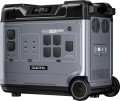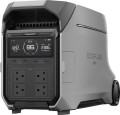Sockets (230 V)
Total number of outlets with output voltage. This is, in fact, the number of devices that can be simultaneously connected to the charging station without the use of splitters, extension cords and carriers. Accordingly, weaker charging stations have
one or
two sockets in their submission.
Powerful charging stations already have three or
more sockets “on board”.
USB A
Full-size USB A connectors are popular in computer technology, they are standardly used in adapter chargers for 230 V household networks and 12 V auto sockets. In charging stations, such outlets are widely used for charging gadgets.
- The total number of such ports can be very diverse (
1 USB,
2 connectors,
3 ports and even
4), since it allows you to connect for charging, and in some cases for power, various low-power devices -
smartphones,
tablets,
power banks,
lamps, etc. .
- The strength of the power. The maximum power output through the USB A connector to the device being charged. Note that different ports of the charging station can output different power (for example, 1.5 A and 2.1 A). In this case, the highest power strength is usually indicated.
— Power. The maximum
output power in watts (W) that the charging station is capable of delivering through the USB A connector to one charging device.
USB A (quick charge)
Full size
USB A ports with fast charging support. It allows you to charge your smartphone, tablet or other connected device much faster. The charging process takes place at increased power, and the current and voltage at each stage are regulated in such a way as to remain within the optimal values. However, it should be borne in mind that in our time there are many fast charging technologies and not all of them are compatible with each other.
- The strength of the current. The parameters of the current issued through the USB A fast charging connectors. Note that different voltage and current parameters can be output to different ports of the charging station. This item specifies the current values at a certain voltage (for example, 5 V / 3 A, 9 V / 2 A, 12 V / 1.5 A).
— Power. The maximum power in watts (W) that the charging station is capable of delivering through the USB A fast charging connector to one charging device. High output power allows you to speed up the charging process. However, the appropriate power must be supported by the device being charged - otherwise the speed of the process will be limited by the characteristics of the gadget.
Car cigarette lighter
Built-in cigarette lighter socket with 12 V output voltage in the design of the charging station. Such an interface is in fact a standard "car socket" used to connect various devices to the car's on-board network. The presence
of a cigarette lighter socket (car outlet) allows you to use the charging station as a power source for such devices. The number of sockets in different models can be different - most often there is one cigarette lighter, but occasionally there are options for a couple of connectors.
Add. ports
Additional output connectors provided in the design of the charging station in addition to those described above.
DC input
DC connector for a distinctive round plug (like those used in many laptops) used to recharge the battery of the device. Note that
DC- in plugs may have different sizes, and chargers with such plugs may have different operating voltages. In practice, this leads to the fact that finding a suitable charger for a portable station is not easy, you need to be especially careful when searching.
Anderson port
A large two-pole connector for connecting batteries, chargers and all kinds of equipment where reliable contact is required for the sake of ensuring stable operation of the equipment.
Anderson Port is resistant to moisture changes, can be used both for indoor and outdoor mechanisms. Thanks to identical mating parts, a pair is formed by two identical connectors, which are rotated 180 ° relative to each other. Most often, Anderson port is used in mobile homes on wheels.
Connecting an additional battery
Ability
to connect an external battery to the charging station to increase the overall energy consumption and, as a result, extend the battery life. This connection is fast and convenient. On the other hand, the battery takes up extra space on the outside, making the whole structure more cumbersome.
Battery capacity
Nominal
battery capacity, in fact - the amount of energy that is supposed to be stored. The larger it is, the longer the battery life of the charging station will be, all other things being equal. On the other hand, this parameter also affects the dimensions, weight and price of the battery, despite the fact that an energy-intensive battery is not always required. By the indicator of capacity in watt-hours, you can compare batteries with each other.

